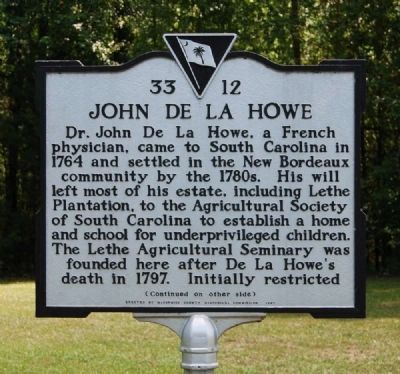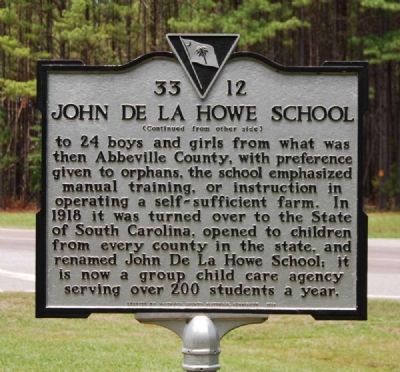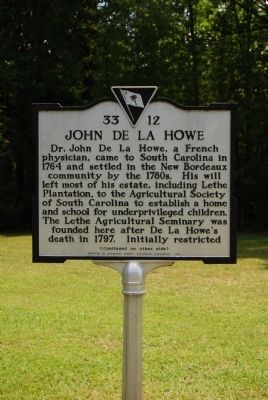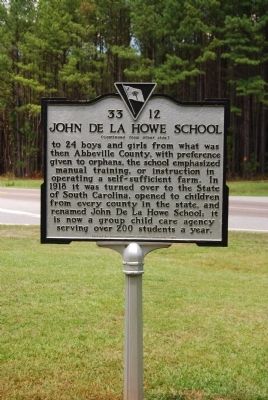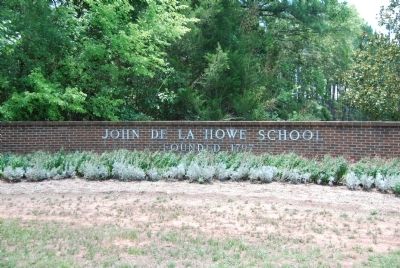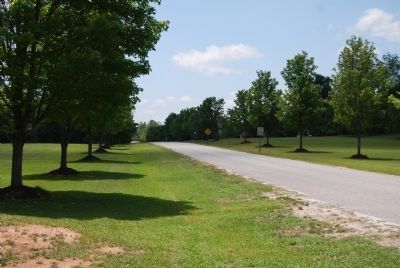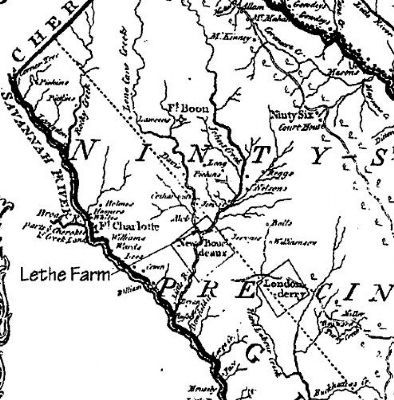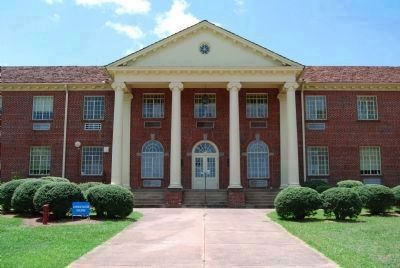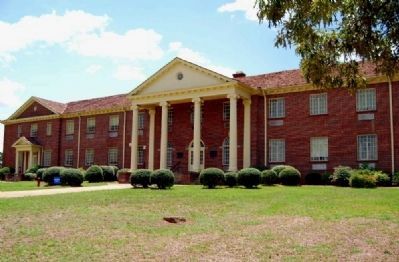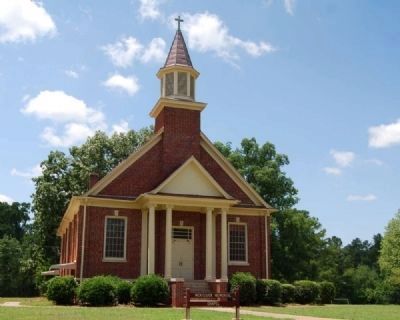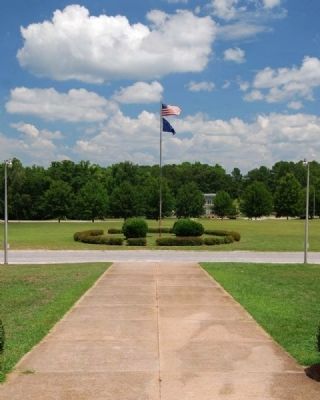Near Bordeaux in McCormick County, South Carolina — The American South (South Atlantic)
John De La Howe / John De La Howe School
Erected 1997 by McCormick County Historical Society. (Marker Number 33-12.)
Topics and series. This historical marker is listed in these topic lists: Agriculture • Colonial Era • Education • Science & Medicine • Settlements & Settlers. In addition, it is included in the South Carolina, McCormick County Historical Society series list. A significant historical year for this entry is 1764.
Location. 33° 57.455′ N, 82° 25.344′ W. Marker is near Bordeaux, South Carolina, in McCormick County. Marker is at the intersection of Branch Road and State Highway 81, on the right when traveling north on Branch Road. Touch for map. Marker is in this post office area: Mc Cormick SC 29835, United States of America. Touch for directions.
Other nearby markers. At least 10 other markers are within 3 miles of this marker, measured as the crow flies. John De La Howe School (approx. 0.2 miles away); De La Howe Hall (approx. 0.2 miles away); John De La Howe School Enterprise Market Program at "The Barn" (approx. ¼ mile away); Guillebeau Home and Family Cemetery (approx. 1.2 miles away); Andre Guillebeau (approx. 1.4 miles away); John De La Howe School Lethe Farm Trail (approx. 2.1 miles away); John De La Howe Forest (approx. 2.2 miles away); New Bordeaux (1764) (approx. 2½ miles away); Cherry Hill / Noble Cemetery (approx. 2.8 miles away); Willington Academy (approx. 2.8 miles away). Touch for a list and map of all markers in Bordeaux.
Also see . . .
1. SC Governor's School for Agriculture at John de la Howe. South Carolina State website entry
Originally founded in 1797 as a farm school for local poor and orphaned children, John de la Howe School has evolved into a first-rate, child caring agency committed to meeting the behavioral, educational, and social needs of the children in its care. (Submitted on July 21, 2008, by Brian Scott of Anderson, South Carolina.)
2. Dr John de la Howe. Find A Grave website entry (Submitted on March 28, 2024, by Larry Gertner of New York, New York.)
3. John De La Howe School. South Carolina History website entry (Submitted on March 28, 2024, by Larry Gertner of New York, New York.)
4. Facebook: John de la Howe School. Official Facebook page of the John de la Howe School. (Submitted on December 12, 2009, by Brian Scott of Anderson, South Carolina.)
Additional commentary.
1. About John de la Howe
The welfare of orphans not taken into homes was mainly left to individual benefactors. John de la Howe settled on the Savannah River after the revocation of the Edict of Nantes. In 1797 he left instructions in his will for his estate to provide for the education and support of twelve poor boys and twelve poor girls, preference to be given to orphans, so that they might be educated in a manner similar to that of an independent French peasant. (Source: In My Father's House Are Many Mansions: Family and Community in Edgefield, South Carolina by Orville Vernon Burton (1987), pg 144.)
— Submitted November 25, 2009, by Brian Scott of Anderson, South Carolina.
2. Dr. John de la Howe Death Notice
Died, on the 2d inst. at Long-Cane, in Abbeville county, district of Ninety-Six, in the 80th year of his age, Doctor John De La Howe. As a practitioner of physic, he was eminent in this country, for upwards of 30 years past; as a man of extensive learning he had few equals, and his benevolence endeared him to all who knew him. About twelve years ago he retired to Abbeville county, of which he was made a judge; there his whole time was spent in assisting those who stood in need of his advice. By his last will, having no children, he has left his estate to support a public school in Abbeville county. (Wednesday Jan. 18, 1797.) (Source: The South Carolina Historical and Genealogical Magazine, Volume 23 by the South Carolina Historical Society (1922), pgs 210-211.)
— Submitted November 25, 2009, by Brian Scott of Anderson, South Carolina.
3. The De La Howe Gift
Dr. John De La Howe, of Abbeville District, on the 7th day of September, 1796, made his last will and testament and thereby gave all of his estate, consisting of both personal and real, to the Agricultural Society of South Carolina, in trust, for the purpose of establishing on the plantation where he resided an agricultural farm and school, out of the yearly income, to feed, clothe and educate twelve poor boys and twelve poor girls, giving orphan children the preference. The testator requested Peter Gibert, Esq., to act as executor of the will until the Agricultural Society should name some of its members to perform that duty. By a codicil, without date, he appointed William Hutton a joint executor with Mr. Gibert. Dr. De La Howe died on the 2d day of January, 1797, and his will was admitted to probate on the 27th of March, 1797, by the County Court of Abbeville. An appraisement was made on the 5th of April, 1797. The appraised value of the personal property at that time amounted to $5,438.68.
In 1805 the Agricultural Society surrendered their trust to the Legislature, who accepted it, and by Act passed on the 14th of December, same year, appointed Col. Joseph Calhoun, Peter Gibert, Andrew Norris, Rev. Moses Waddel, Ezekiel Calhoun, trustees, to carry into effect the terms of the will, conferring on them the power to fill their own vacancies, and directed them to account Annually to the Ordinary of Abbeville District.
On the 30th of December, 1806, the trustees sold the residue of the personal property. This sale amounted to $6,556.14. On the 27th of June they returned a statement of the personal estate, at that time amounting to $10,639.69.
The real estate consisted of quite a number of tracts of land situated in the Districts of Abbeville, Edgefield, and on the Edisto River. A certain part of the land was sold about this time, which produced a sum—added to the amount realized from sale of personal property—aggregating some $32,237.
The institution has had a changing experience since the above date. Today the institution is in possession of 2,700 acres of land, valued at $54,000, besides having $14,000 invested in good bonds. There is erected on the premises one brick building containing twelve rooms for the use of Superintendent and girls, and one four-room brick building for the boys, a commodious chapel in which preaching is held regularly—preacher paid by the trustees. The annual income of the farm is $3,500; expenses for maintaining school, Superintendent, etc., are $2,000.
In view of the above facts, it is strange to state that the trustees find great difficulty in procuring as many children as the school can accommodate. Notwithstanding the fact, the trustees are now begging for children from adjoining counties, offering to pay their transportation from and to the institution, educate, feed, clothe and pay their medical expenses. I must admit I am unable to explain this state of circumstances.
Dr. De La Howe was buried on the hill opposite to the dwelling on the plantation named by him "Lethe Farm." He requested a substantial brick wall should be built around his grave—not less than ten feet square, eight feet above the ground, with an iron door and lock, and that the following inscription, in large iron capitals, shall ever be kept encased: "Joes De La Howe, fundator, hipes Seminarie Agriculturalis," with date of his decease. (Source: Handbook of South Carolina, 2nd Edition by South Carolina Department of Agriculture (1908), pg 215.)
— Submitted November 25, 2009, by Brian Scott of Anderson, South Carolina.
4. Description of the De La Howe School
The American Farmer
1831
We have no information of the character of the deceased, nor of his wealth or will, but what is contained in an advertisement which we find in a South Carolina paper. By this advertisement it appears that provision is made in the will of the late John De La Howe for the education of twenty-four poor children, twelve boys and twelve girls. The trustees appointed to carry the will into effect, advertise for a teacher to superintend a farm school as planned and provided for in the will of the deceased. They have provided a good farm, suitable buildings, utensils, provisions and necessary stock, and offer a liberal salary for a teacher. According to the plan of the school in the will, the children will live together in one family, and the expenses are to be defrayed out of the funds of the estate with the addition of the labor of the children on the farm.
— Submitted November 25, 2009, by Brian Scott of Anderson, South Carolina.
5. An Act to Establish the Dr. John De La Howe Industrial School
An Act to Establish the Dr. John De La Howe Industrial School, and Provide for Its Government and Maintenance.
Section 1. Dr. John De La Howe Industrial School Established.—Be it enacted by the General Assembly of the State of South Carolina, That there shall be, and is hereby, established under the provisions of this Act an institution to be known as the "Dr. John De La Howe Industrial School."
§ 2. Body Corporate—Powers.—That the Dr. John De La Howe Industrial School is hereby declared to be a body corporate and, as such, may sue and be sued, plead and be impleaded, in its corporate name; may have and use a proper seal, which it may alter at its pleasure; and shall have the right to acquire by purchase, deed, devise, lease for a term of years, bequest, or otherwise, such property, real and personal, in fee simple without limitations, as may be necessary or proper for carrying out the purposes of its organization as herein declared.
§ 3. Appointment of Trustees—Term of Office.—That the business, property and affairs of the said Industrial School shall be under the control of a Board of Trustees, consisting of five members, who shall be appointed by the Governor, subject to confirmation by the Senate. The terms of the members of the said Board first appointed shall be one, two, three, four and five years, respectively, commencing on the first day of April, nineteen hundred and eighteen, and thereafter upon the expiration of the term of a member of the said Board, his successor shall be appointed for a term of five (5) years; appointments to fill vacancies caused by death, resignation, or removal before the expiration of such terms shall be made for the residue of such terms in the same manner as herein provided for original appointments.
The members of the said Board may at any time be removed by the Governor for good cause. The failure of any member of the said Board to attend at least one meeting thereof in any year, unless excused by formal vote of the Board, may be construed by the Governor as the resignation of such non-attending member. The said Board shall meet quarterly and oftener as may be required, at least one meeting each year being held at the said Industrial School. The said Board shall appoint an Advisory Committee of three women, for such terms as the said Board may determine, who shall visit the said Industrial School at least quarterly, and shall advise with the said Board as to its management and any other pertinent matters. All members of said Board and of the Advisory Committee of women shall serve without compensation, but their necessary traveling and other expenses shall be paid.
§ 4. Election and Powers of Superintendent.—That the said Board shall elect a Superintendent for said Industrial School, at such salary and for such term as they may fix. Thereafter, the Superintendent shall employ and discharge all employees of the said Industrial School, subject to the approval of the said Board.
§ 5. Oath of Trustees and Superintendent.—That all the members of the said Board and the Superintendent of the said Industrial School, shall, before entering upon the discharge of their duties, take an oath faithfully to perform any and all duties imposed upon them under this Act and amendments hereto. The Superintendent shall execute a bond payable to the State in such sum as shall be required by the said Board, with sufficient security, which bond shall be filed in the office of the Secretary of State.
§ 6. Purpose of School.—That in establishing the Dr. John De La Howe Industrial School, it is hereby declared to be the purpose and policy of the State to take over the property, now in McCormick, but formerly in Abbeville county, left by Dr. John De La Howe, and to maintain and develop same in accordance with the purposes of the will of the said Dr. John De La Howe as interpreted by the Supreme Court of South Carolina, Mars v. Gibert, 93 South Carolina, pages 455-467, namely: "First, The establishment and maintenance of an agricultural and mechanical school as an institution in Abbeville county, stimulating and improving the industrial life of the entire community; second, the training, free of charge, of twenty-four boys and girls, not as college men and women, but in the beginning of school life; and, third, the like training of the children of the neighborhood not supported by the fund." It is hereby declared, however, that the terms "Abbeville county" shall be understood to mean that portion of South Carolina known as "Abbe
ville county" at the time this will of Dr. John De La Howe was dated, namely, January 2, 1797.
§ 7. Trustees to Make Rules—Admission of Pupils.—That in accordance with the purposes of the said Industrial School as herein defined, the said Board of Trustees shall make such rules and regulations for their own government and for the management of the said Industrial School as they may deem necessary, consistent with the laws of this State and with the terms of the will of Dr. John De La Howe: Provided, That all applications for admission as boarding pupils shall be submitted by the said Board of Trustees to the State Board of Charities and Corrections before being granted. Thereupon, the State Board of Charities and Corrections shall investigate the applications and report their findings with their recommendations to the said Board of Trustees, who shall then, in accordance with such rules as they may make, determine which of these applications for admission shall be granted and in what order: Provided, further, That it is hereby declared to be the policy of the State that pupils at the said Industrial School, whose estates are sufficient, or the relatives of said pupils liable in law for their support, whose estates are sufficient, shall be required to pay for the maintenance of such pupils in said Industrial School in whole or in part; the manner and method of determining such financial ability and the collecting of the amounts required to be paid shall be similar to that now in force with regard to the students in the State colleges.
§ 8. Appropriation for Building—Certain Funds to Be Delivered to Trustees.—That for the purpose of erecting an adequate building for the use of said Industrial School and for further carrying out the provisions of this Act, the sum of thirty thousand ($30,000.00) dollars is hereby appropriated out of the funds of the State not otherwise appropriated, fifteen thousand ($15,000.00) dollars to be paid
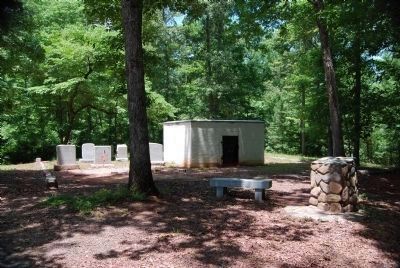
Photographed By Brian Scott
12. John De La Howe Forest Marker and Cemetery
The white structure is De Le Howe's Crypt. His wishes were that his grave not be marked by a headstone or monument, but by a wall. Others buried in the small cemetery are: Grave 1: Rev. James Bennett Branch, Aug 2, 1882-Jul 8, 1931, Superintendent of the de la Howe School, 1919-1931; his wife, Nora Pryse Branch, Apr 3, 1881-May 4, 1983. Grave 2: James Bennett Branch, Born Nov 13, 1921, Died May 10, 1945; He gave his life in the service of his country at the battle of Okinawa in WWII. Grave 3: Mary Naomi Beard, Mar 12,1909-Jun 9, 1936, wife of P.B. Moragne. Grave 4: Ernest Gray, Born Jul 28, 1916, Died May 18, 1929. Grave 5: In memory of Clifford Williams, Jan 1, 1919-Jan 23, 1929. Grave 6 and 7: Unmarked.
§ 9. Act Effective on Approval—Inconsistent Acts Repealed.—That this Act shall take effect immediately upon its approval by the Governor; and all Acts or parts of Acts in conflict with the provisions of this Act are hereby repealed.
Approved the 19th day of February, A.D. 1918. (Source: Acts and Joint Resolutions of the General Assembly of the State of South Carolina (1917), pgs 803-807.)
— Submitted December 8, 2009, by Brian Scott of Anderson, South Carolina.
6. The Estate of De La Howe Invested in Trustees Instead of the Agricultural Society
46. Whereas, The late Dr. John De La Howe, by his last will and testament, vested certain real estates in the district of Abbeville, in the agricultural society of this state, for the uses and purposes set forth in the said will: And whereas, tho said trustees have petitioned the legislature to accept of their resignation of the said trust:
47. Be it therefore enacted, That the legislature of this state do hereby accept of the resignation of the said trustees. and that all powers, authorities and duties vested in or imposed upon the said trustees, do for ever hereafter cease and determine.
48. And be it further enacted, That col. Jos. Colhoun, Peter Gibert, Andrew Norris, the rev. Moses Waddell, and Ezekiel Colhoun. be, and they are hereby appointed trustees for the purposes of carrying into effect the said last will and testament of the said Dr. John De La Howe, and that they are hereby vested with as full and ample powers, privileges and authorities, as the said agricultural society, by the said last will and testament of the said Dr. John De La Howe was vested with.
49. And, be it further enacted, That in case of the death or resignation of any of the commissioners herein before named, that the others or survivors shall have, and are hereby vested with full power and authority to fill up and supply every vacancy or vacancies so occurring. Provided always, That the said commissioners do annually account before the ordinary of Abbeville district, in the way and manner in which executors and administrators are by law required to account.
50. Be it enacted, That so much of the clause of an act, entitled, "An act to establish a new district therein mentioned," passed on the nineteenth day of December, one thousand eight hundred and one, as relates to the appropriation of the money arising from the sale of certain lots in Conwayborough, be, and the same are hereby repealed; and that Henry Durant, Benjamin Gauze, Anthony Pawley and Edward Connor, be, and they are hereby appointed commissioners to supply the vacancies occasioned by the death of Samuel Foxworth, and the resignation of William Verreen, William Williams, and John Graham, and in addition to the commissioners appointed under the aforesaid act, and passed in the year of our Lord one thousand eight hundred and one, and they or the majority of them, be, and they are hereby authorized and empowered to continue the sale of the said lots, and to receive the money arising from such sale, and to put to and keep at interest the principal sums arising from such sale, and to appropriate the interest arising therefrom to the educating of poor orphan children, and the children of poor parents who are not able to educate them. (Source: An Alphabetical Digest of
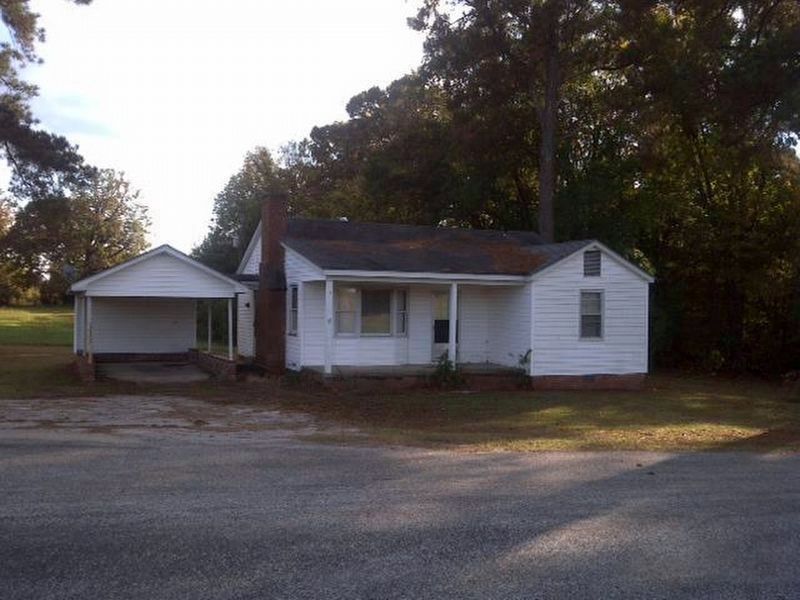
Photographed By Fred L. Schumpert
15. John De La Howe / John De La Howe School Marker
After living in the former campus' original Old Infirmary, across from the Branch House, near the entrance to John de la Howe, for over a year (1948), while the school was constructing a more permanent house in which to live, we moved to this small frame house across from the peach/pecan orchard, what was called the "tomb road".
— Submitted December 12, 2009, by Brian Scott of Anderson, South Carolina.
7. Excavations at Lethe Farm
At John de la Howe's home site, Lethe Farm, excavations around the main house and a detached kitchen building, supplemented by a site-wide shovel tested survey, yielded almost no artifacts of French origin. A few shards of tin-glazed earthenware are somewhat arbitrarily considered "French" rather than English. Shreds from a Normandy stoneware storage jar are French in origin; these plus a French coin dated 1785 and a Bordeaux wine bottle are the only artifacts that can be segregated. Examining Dr. de le Howe's will and inventory, there is nothing listed that indicated that he spent his first fifty years in France other than a few medical books written in French -- and of course he also had volumes written in German, Latin, and English.
The most important thing we found at the site was clearly French in origin was Dr. de la Howe's house itself. This building was marked by a rectangular mound of clay daub. Beneath this pile of daub and clay the remains of a wall trench and posts are evidence of a French-style poteaux en terre structure. This is significant because it represents something that the French could bring to the colonies -- knowledge of house-building techniques -- and that would show up clearly in the archaeological record.
We were able to identify the locations of ten structures at the Lethe Farm site other than the main house. All of these were marked by stone foundations. While they may be the remains of French-style poteaux sur sole structures, which were built on stone and wooden foundations, none yielded any daub, or bouissilage, the clay packing that would be used to form the walls...
At Lethe Farm only one building had wall trenches and clay walls, the home of Dr. de le Howe. His slaves were either forced to live in log houses or did so voluntary. While de la Howe was a singular individual and clearly does not reflect the norm, this and all other evidence points more to a French origin for this architecture than an African origin. This mixing of cultural influences stands as a constant in the development of an American social identity, and in the attendant loss of previous ethnic affiliations. (Source: Another's Country: Archaeological and Historical Perspectives on Cultural Interactions in the Southern Colonies by J.W. Joseph and Martha Zierden (2002) pgs 154, 156.)
— Submitted December 12, 2009, by Brian Scott of Anderson, South Carolina.
Credits. This page was last revised on March 28, 2024. It was originally submitted on July 21, 2008, by Brian Scott of Anderson, South Carolina. This page has been viewed 3,550 times since then and 107 times this year. Photos: 1, 2. submitted on November 25, 2009, by Brian Scott of Anderson, South Carolina. 3, 4, 5, 6. submitted on July 21, 2008, by Brian Scott of Anderson, South Carolina. 7. submitted on November 23, 2009, by Brian Scott of Anderson, South Carolina. 8. submitted on July 21, 2008, by Brian Scott of Anderson, South Carolina. 9. submitted on December 12, 2009, by Brian Scott of Anderson, South Carolina. 10. submitted on July 17, 2009, by Brian Scott of Anderson, South Carolina. 11. submitted on November 25, 2009, by Brian Scott of Anderson, South Carolina. 12. submitted on July 21, 2008, by Brian Scott of Anderson, South Carolina. 13. submitted on November 25, 2009, by Brian Scott of Anderson, South Carolina. 14. submitted on December 8, 2009, by Brian Scott of Anderson, South Carolina. 15. submitted on April 6, 2021, by Fred L. Schumpert of Lookout Mountain, Tennessee. • Christopher Busta-Peck was the editor who published this page.
